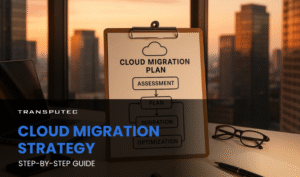Cloud Services stand as a beacon of innovation. It’s not just about remote data storage; it’s about redefining application management, resource accessibility, and nurturing creativity. As we navigate this digital realm, understanding the three fundamental categories of Cloud Services becomes pivotal for unlocking the true potential of the Cloud.
From Infrastructure as a Service (IaaS), which offers virtualised computing resources, to the collaborative ingenuity of Platform as a Service (PaaS), streamlining application development and management, and the future-ready solutions of Software as a Service (SaaS), this journey will illuminate how each category opens doors to innovation, scalability, and a renewed business landscape. Let’s delve into the intricacies of these essential Cloud Services and unearth their transformative impact.
Infrastructure as a Service (IaaS): The Bedrock of Cloud Computing
Infrastructure as a Service (IaaS) forms the bedrock of cloud computing. Through IaaS, organisations lease virtualised computing resources over the internet. From virtual servers to networking components, IaaS eliminates the need for physical hardware and empowers businesses to scale as required. Think of it as a personalised virtual data centre, minus the complexity.
IaaS provides an indispensable solution for businesses seeking flexibility and agility. By outsourcing the burden of hardware management, organisations can allocate resources where they matter most – driving innovation and strategic growth. Scaling up or down becomes seamless, catering to dynamic business demands without the worry of over-provisioning or resource constraints. Moreover, IaaS serves as a gateway to cutting-edge technologies, enabling easy adoption of new tools and services, and keeping businesses ahead in the ever-evolving digital landscape. With IaaS as a reliable foundation, businesses can build and expand their operations without the hurdles of traditional infrastructure management.
Platform as a Service (PaaS): Fostering Innovation and Collaboration
Platform as a Service (PaaS) takes Cloud Services to the next level by offering a platform where developers can build, deploy, and manage applications without dealing with the underlying infrastructure. PaaS fosters a collaborative environment where cross-functional teams can seamlessly collaborate on projects. This abstraction accelerates development cycles, ignites experimentation, and nurtures a culture of innovation.
PaaS unleashes a world of creative potential by removing the complexities of infrastructure management. It serves as a playground for developers, allowing them to focus on coding, testing, and refining applications rather than grappling with hardware intricacies. The collaborative element of PaaS amplifies its impact, breaking down silos between teams and facilitating real-time interactions. This fosters innovation through collective brainstorming, shared expertise, and a faster feedback loop.
PaaS paves the way for faster application deployment, reducing time-to-market and enhancing the overall customer experience. By offering an environment for experimentation, it emboldens businesses to push boundaries, embrace change, and constantly iterate towards improvement. With PaaS as a foundation, the horizon for innovation expands, leading to novel solutions and transformative business outcomes.
Software as a Service (SaaS): Embrace Efficiency with Ready-to-Use Cloud Services Solutions
Software as a Service (SaaS) delivers software applications via the internet under a subscription model. From productivity tools to CRM systems, SaaS removes the need for local installations and upkeep. Businesses gain access to ready-made solutions that are consistently updated and supported, freeing resources for strategic endeavours.
SaaS represents a paradigm shift in how businesses approach software applications. It eliminates the cumbersome process of traditional software installation, updates, and maintenance. With SaaS, organisations no longer need to worry about compatibility issues, version control, or hardware upgrades.
This model not only streamlines operations but also ensures that businesses always have access to the latest features and security patches. The subscription-based approach provides cost predictability and eliminates the need for upfront investment in software licenses. As SaaS applications are hosted in the cloud, they offer the flexibility to access tools and data from anywhere, fostering a culture of remote work and collaboration.
Moreover, SaaS providers bear the responsibility of maintaining infrastructure and security, granting businesses the peace of mind to focus on core operations. SaaS doesn’t just simplify processes; it catalyses growth by freeing resources and enabling businesses to allocate their time and efforts towards innovation and strategic initiatives.
Conclusion
Cloud Services have emerged as a transformative force that empowers businesses to reach new heights. Through cloud services such as Infrastructure as a Service (IaaS), Platform as a Service (PaaS), and Software as a Service (SaaS), organisations gain the ability to streamline operations, foster innovation, and access future-ready solutions.
With Transputec, you get a friendly team that guides you through everything you need to know about Cloud Services. We don’t just offer a one-size-fits-all solution; we listen to what you need. Ready to explore the transformative potential of Cloud Services for your organisation? Connect with our experts to witness how Transputec can elevate your business to new heights.







